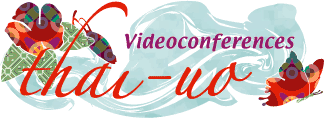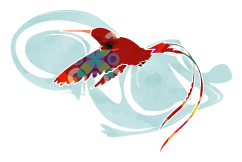Archived Series – Integrated Skills
 |
||
 |
Documents |
2004-05 Archived Handouts and Resources Handout: Integrated Skills |
Videos |
2004-05 Archived
|
2004-05 Archived Series – March 18, 2005
Integrating the Four Skills in the Communicative Classroom, Focus on Reading Activities
Sarah Klinghammer and Leslie Opp-Beckman, Speakers
March 18, 2005
Overview
This is the fifth lecture in a 10-part professional development series for English as a Foreign Language educators in Thailand. University of Oregon is partnering with the US Embassy in Bangkok, the Royal Thai Distance Learning Foundation, colleagues at Chulalongkorn University, and at ThaiTESOL on this innovative and exciting project.
About the Speakers
Dr. Klinghammer returns for a second time as a guest speaker (she launched the series with the first session). She is Director of the Language Teaching Specialization MA degree in the UO Linguistics department.
Leslie Opp-Beckman is on faculty at the University of Oregon in the Linguistics Department and the American English Institute. She develops e-learning curriculum and and teaches courses on Computer-Assisted Language Learning.
Discussion Questions
- How are the five principles of language teaching (as introduced in the first session on Innovative Approaches, November 19, 2004) reflected in the reading strategies and activities suggested in this lecture?
- What forms of assessment do you recommend for these kinds of activities?
- How can we acquire or create our own “literacy rich” classroom environments?
Online Resources
The following reading provides background to the lecture and the suggested activities from this session.
- Integrated Skills in the ESL/EFL Classroom. ERIC Digest.
ERIC Identifier: ED456670. One image for teaching English as a second or foreign language (ESL/EFL) is that of a tapestry. The tapestry is woven from many strands, such as the characteristics of the teacher, the learner, the setting, and the relevant languages (i.e., English and the native languages of the learners and the teacher). For the instructional loom to produce a large, strong, beautiful, colorful tapestry, all of these strands must be interwoven in positive ways. By examining segregated-skill instruction, we can see the advantages of integrating the skills into a “tapestry” and move toward improving teaching for English language learners.
True or “Weird” news stories provide reading materials that are often in simplified (abridged) text on high-interest, real-life topics. Some examples of sites where you can find this type of high-interest (and usually short) news follow.
The following resources are related to some of the classroom activities that were discussed in the lecture.
- Dialogue Journals: Interactive Writing to Develop Language and Literacy
Teachers of both children and adults often wish they had more time to communicate with their students–to learn about their backgrounds, interests, and needs; to share information; and to follow their learning. Many teachers of such students have found dialogue journals, interactive writing on an individual basis, to be a crucial part of their classes. Dialogue journals not only open a new channel of communication, but they also provide another context for language and literacy development. Students have the opportunity to use English in a non-threatening atmosphere, in interaction with a proficient English speaker. Because the interaction is written, it allows students to use reading and writing in purposeful ways and provides a natural, comfortable bridge to other kinds of writing. • - Eduplace, Wacky Web Tales
Fun fill-in-the-blank story activities that your students can’t resist doing again and again. Combines review of parts of speech with reading. Every story has a creative “twist” every time. No two stories are alike. - Quandary Action Maze Examples
Interactive reading adventures. Online connection required. - Readers Theater, Directory of Resources
Reader’s theater is minimal theater in support of literature and reading. Originally popular on college campuses, reader’s theater has now moved to the lower grades, where it is seen as a key tool for creating interest in reading. There are many styles of reader’s theater, but nearly all share these traits:
* No full memorization. Scripts are held during performance.
* No full costume. If used at all, costumes are partial and suggestive, or neutral and uniform.
* No full stage sets. If used at all, sets are simple and suggestive. Narration provides the framework for dramatic action. Reader’s theater was developed as a convenient and effective means to present literary works in dramatic form. This is still its primary use, though many scripts now published are original dramatic works rather than literary adaptations.
EduRef (formerly AskERIC) has many example lesson plans for secondary level students that incorporate reading and an integrated skills approach. See, for example:
For more on these topics, look for the teacher trainer handouts on:
Post-lecture Classroom Applications
Choose one of the suggested activities from the lecture and try it in one of your classes. Share your results with at the next videoconference session, or with colleagues from your school or region.